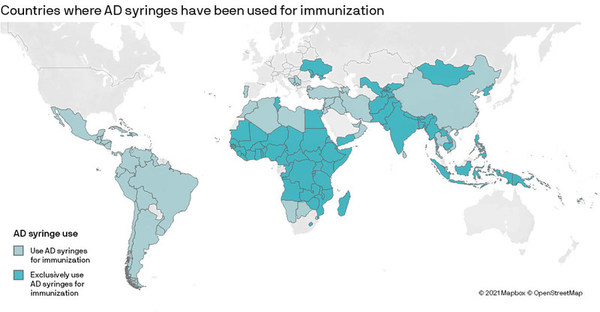A supply gap of more than 1 billion autodisable syringes could impact COVID-19 immunization efforts in 100 countries
SEATTLE,Nov. 18,2021 --New PATH modeling estimates a global market supply gap of 1.2 billion autodisable (AD) syringe safe-injection devices for COVID-19 vaccine delivery. This supply gap risks becoming a bottleneck that could threaten the timely delivery of vaccines in half of the countries on Earth.

Immunization is done exclusively with AD syringes in nearly 70 countries,and 30 countries use them for some immunizations. Since 1999,the WHO,UNICEF,and the United Nations Population Fund have recommended exclusive use of AD syringes globally for immunization as they “present the lowest risk of person-to-person transmission of blood-borne pathogens such as hepatitis B or HIV” because AD syringe needles cannot be removed or reused.
On November 11,PATH and the United Nations Children's Fund (UNICEF) held a Global COVID-19 Vaccine Syringe Industry Convening bringing together more than two dozen of the world's leading syringe manufacturers and multilateral organizations to facilitate increased transparency around the AD syringe market to help bolster supply for COVID-19 vaccines as well as routine immunization. Manufacturers confirmed critical global AD syringe supply challenges from the end of 2021 through mid-2022,despite tripling their production and efforts by multilateral organizations to secure additional AD syringes for low- and middle-income countries that need them.
The projected spike in demand for syringes for COVID-19 vaccines,estimated to total more than 4 billion from the end of 2021 to mid-2022,is due to the anticipated surge in COVID-19 vaccine dose deliveries to countries coming through COVAX,large donations from governments,and bilateral deals. Based on the global supply and demand data,the PATH modeling estimates a global gap of 1.2 billion AD syringes.
Risks to syringe supply such as country export restrictions,shipping delays,new manufacturing lines failing to receive World Health Organization (WHO) prequalification,or delays in completing planned manufacturing expansions could widen the cumulative gap to more than 2 billion during this period. Booster doses could create additional demand pressures on the market.
"Our gap analysis is designed to demystify the market and spur efforts in both public and private sectors to prioritize equitable access to COVID-19 vaccines and syringes in every country as well as to safeguard syringe supplies for essential vaccines for children," said Tara Herrick,Senior Market Analytics Officer,PATH. "While these future projections are not set in stone,collectively our actions could help curtail the size of future gaps to help reach the global COVID-19 vaccination target of 70 percent by 2022."
Immunization is done exclusively with AD syringes in nearly 70 countries,and the United Nations Population Fund have recommended exclusive use of AD syringes globally for immunization as they "present the lowest risk of person-to-person transmission of blood-borne pathogens such as hepatitis B or HIV" because AD syringe needles cannot be removed or reused.
Importantly,all AD syringes provide fixed doses,meaning they can only be filled with the exact amount for one vaccine dose. Most vaccines,including those for many essential childhood immunizations,are administered using a 0.5-mL dose volume and matching AD syringe. The logistical hurdles associated with delivering AD syringes have widened with evolving vaccine developments,such as the recent large-scale availability of the Pfizer vaccine requiring a specialty low-dead-space 0.3-mL AD syringe,which has never been produced before. New sizes of syringes divert production lines from producing standard AD syringes and add to the challenges of matching vaccine doses with the correct size of syringe at the point of immunization.
"To avoid delays to COVID-19 vaccination timelines,human ingenuity will be needed to address these challenges," said Courtney Jarrahian,Program Advisor,PATH. "However,use of safe injection devices and safe injection practices should remain paramount to sustain the gains that have been made to eliminate bloodborne disease transmission from needlestick injuries and misuse of syringes."
https://www.path.org/resources/technologies-injection-safety-historical-overview-and-current-status/Potential gap-filling mechanisms to accelerate access,minimize delays,improve safety,and build sustainable supply include:
Expand manufacturing capacity through strategic investment and incentives to build sustainable supply and decrease shipping delays: Donors,investors,and governments can draw on the tools used to incentivize vaccine suppliers,including grants,no- or low-interest loans,and volume guarantees to offset some risk to suppliers. It is especially important to expand local syringe manufacturing in Africa and Latin America,where there is a limited supply base and lengthy shipping times for overseas supply.
Reevaluate use scenarios: Until the AD syringe shortage is resolved,countries able to use other types of safety syringes could help conserve the AD syringe supply for countries with constrained health systems.
Standardize vaccine dose volumes: If vaccine manufacturers would formulate new COVID-19 vaccines,boosters,and pediatric doses to match existing fixed-dose AD syringes,it would streamline logistics,manufacturing,and immunization campaigns.
Avoid national export restrictions which further limit supply: Countries with syringe manufacturing capabilities could help address global supply gaps to meet the 70 percent immunization target.
PATH will continue to monitor the market,with anticipated updates to the data in 2022 if there are significant changes. Previous PATH modeling released in December 2020 identified key risks,including demand uncertainty as well as timing,shipping logistics,and warehousing constraints.
Read more about the model's methodology,inputs,and public data sources.
About PATH
PATH is a global nonprofit dedicated to achieving health equity. With more than 40 years of experience forging multisector partnerships,and with expertise in science,economics,technology,advocacy,and dozens of other specialties,PATH develops and scales up innovative solutions to the world's most pressing health challenges.
Media Contact: Lindsay Bosslet,media@path.org